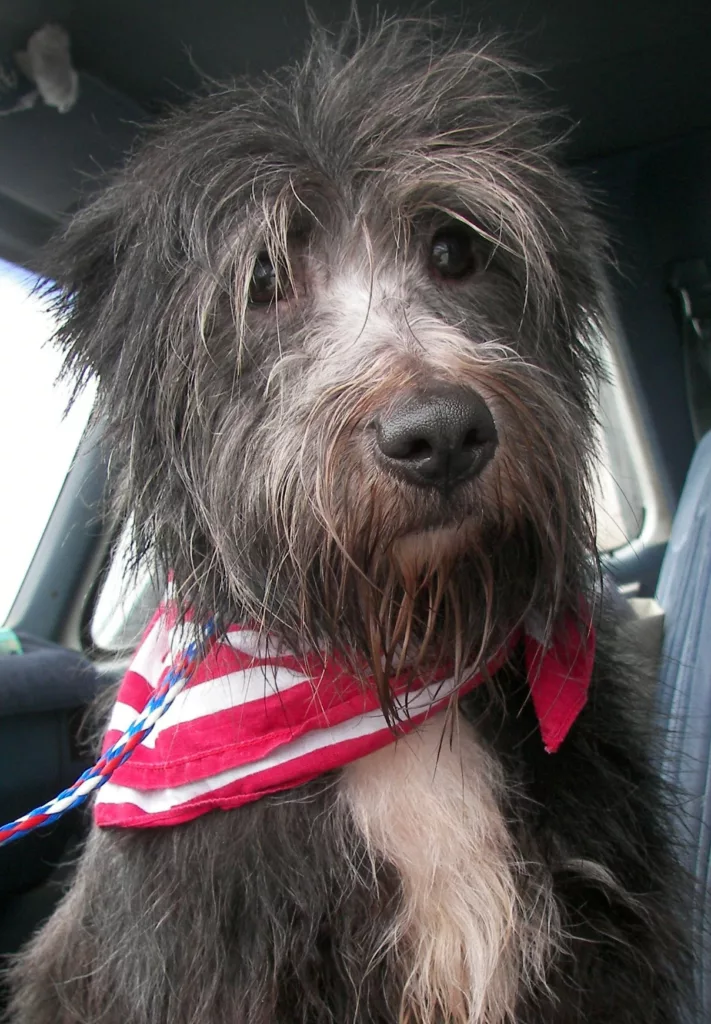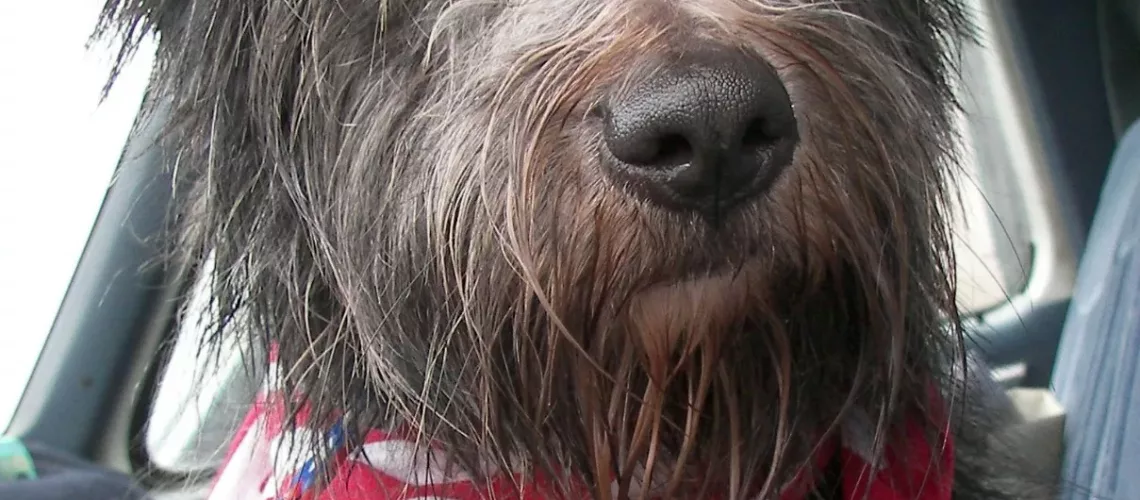If your dog is less than thrilled about riding in the car, this one’s for you!
Behavior is never stagnant. It is heading in some direction. Closely observe your dog and the behaviors he is showing you.

Which Car Riding Dog is Yours?
- “A” dogs may be hesitant to approach the car. You may be able to coax them in but maybe you have to lift them in. Once inside, they may be shut down and quiet, stay where you want them, but they merely tolerate the ride. Maybe they throw up along the way due to stress and anxiety.
- “B” dogs may run to the car at top speed. Their leash skills and self-control are lacking and that results in you having little control over how you get them into and out of the car. They have SO much fun in the car that you can’t keep them in one place. They may bounce around and they may bark at things they see outside the windows. They may even try to get on your lap which is unsafe for everyone involved.
- “C” dogs love car rides and look to you for guidance as you approach the car. They wait for you to ask them to get in and they relax on the ride. They don’t leap out as soon as the door opens; they remain safely in the car until you get collar or harness and leash secured and ask them to get out. This set of behaviors ensures safety in parking lots and on the road.
* Your dog’s behavior may not match any of these scenarios exactly! Watch your dog closely for the body language clues that will tell you how much of an Easy Rider he or she really is.
You guessed it – “C” is our goal! The exercises in this post can help change your dog’s behavior regarding car rides, whether you have an “A” dog or a “B” dog. Even if your dog is already behaving at a “C” goal level, he can continue to move his behavior along a path toward even more self-control and relaxation! When your car is in the garage, Easy Rider training gives you some activities to engage your dog’s mind on rainy days.
Training Your Dog to be an Easy Rider in the Car
1. Training at a Distance
How Far from the Car?
“Ask” your dog! Whether 5 feet or 30 feet away, set up your training area where you observe that your dog is calm and relaxed with a wiggly, loose body, and willing to take treats.
- Taking treats is a sign of feeling comfortable! If your dog won’t take them, increase the distance. Find the spot where he WILL take them.
- Don’t worry if it seems SO far that you’ll never get to the car! You will. “Slow is smooth and smooth is fast” – it’s good enough for the U.S. Navy Seals.
Brief & Bulletproof Training Sessions
- At your specific distance, do a little bit of training for 1-2 minutes.
- Practice behaviors your dog is good at; reward with treats. Everything you do is associated with the car and you want those associations to be over-the-top enjoyable – the best treats, the easiest behaviors!
- Sitting, walking back and forth or in a circle on a loose leash, touching your hand with his nose, a trick your dog knows – vary the behaviors you ask for and reinforce so your dog is thinking and having fun.
2. Come a Little Closer: 1 foot at a time
- When is he ready? Try it. If he’s just as happy doing the training 1 foot closer, he’s ready. If you see any changes in body language (stiffening, less wiggly, ears pulled back, whale eyes, hesitation, etc.) go back to where you were.
- Keep moving closer as quickly as your dog is ready, but don’t hesitate to go back to where you were if he needs you to!
- Notice the other stimuli that may be affecting your dog during a training session: weather changes, dogs barking nearby, how he feels about other things going on, what has happened recently. . . .
3. Open Your Dog’s Own Car Door
- Establish the routine you’ll be using for getting into the car.
- Decide where you want your dog to sit on rides.Choose the door he’ll enter; that’s the door you’ll open for training.Plan the path he’ll follow from the door to get to his spot.
- Do the same easy exercises with the car door open, once your distance is shorter.
4. Let the Car Give the Treats!
- Place a row of treats on the threshold of the car door.
- Have your dog wait while you set them up, then release him to go get them.
- This isn’t intended to be a formal “stay” – you can have someone else hold his leash or tether him so you can set up the treats, put him in the house, or just stand between him and the treats – depending on his level of self-control.
- This is a relaxed exploration game – try not to “help” him!
- If you have an “A” dog, he may need to take his time to reassure himself that the car is safe and not a monster waiting to swallow him up, even after you’ve given him all the preparation described in step 2. Look for curiosity. Your “A” dog will not race forward to grab the treats like a “B” dog would. But if he’s curious, not pulling back or moving away from the car, give him time to explore. If he is too scared to come forward to get the treats, you’ll need to move further away again. This is not a setback, it’s teaching your dog at a level he can succeed with.
- If you have a “B” dog, he may need to gather his self-control to focus on problem-solving rather than leaping into the car like a wild thing!
- Practice a Lot! Just one time will help a little, but many repetitions will build a strong association between the car and good things. It will build confident behavior for your scared “A” dog and self-control for your silly “B” dog.
5. Get In / Get Out
- Time to briefly go through your routine: ask your dog to get in, reward, and then ask him to get out.
- This is not just one behavior, so your dog gets several treats throughout!
- Practice this alone – no dog – to test your plan and get an idea of how to avoid likely errors.
- Start with the car door open. Don’t change things by opening and closing the door just yet.
- Have your dog wait until you ask him to enter the car. (I like for my dog to “sit” – it gives me a second to check my plan and get my treats ready.)
- Ask him to get in. (It doesn’t have to be a verbal cue! Lead him in with your hand, nod your head – by this time, he may already want to get in and you’ll just be allowing him to do so!)
- Be prepared to help him get to his assigned place. This is why you use the same door every time, especially if the path to his place is complicated.
- Be sure you know HOW your dog will jump in so you don’t get in his way. Will he jump to the floor first, and then onto the seat? Directly onto the seat? Will he jump onto the tailgate and then go into a crate or onto a dog bed? Planning is essential.
- Give him a treat when he gets to his place.
- Ask him to come out. You did it!
6. Go for a Ride! (Maybe)
- If your dog’s body language shows you he’s ready, grab a bag of treats and take him around the block.
- Your dog is LEARNING ALL THE TIME. Give him treats along the way or bring along a stuffed Kong or a chewbone that he likes. Continue building good associations with the car: it’s different when it’s running!
7. Train with the Engine Running
- A car with the engine running incorporates noises and vibrations into the process; maybe even different smells. Your dog may need more help before a ride.
- If your dog is comfortable being in the parked car but his behavior and body language changes once the car is started, your next steps are to generalize his feelings of comfort and confidence to the car with the engine running.
Have fun with Easy Rider Car Training!
Make it easy for yourself and your dog. Every little bit of training you do with your “A” or “B” dog to build relaxation and voluntary participation into car rides will get you closer to your goal of a “C” dog.
Your dog can only do what he can do. He’s not trying to be difficult. Don’t discount his fears or his inability to control himself; help him overcome these issues. The two of you will reap the benefits for years to come.
Be the first to read our monthly training application blog posts, designed for you to use with your own pet right away! Subscribers also receive a monthly education and inspirational post about training and behavior, best enjoyed with a cup of coffee or the relaxing beverage of your choice. Sign up for our mailing list at the bottom of this page!


